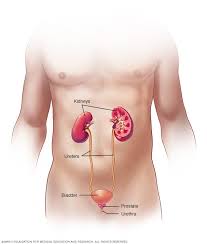Some symptoms can include pressure, spasms, waves of pain in your side, and even a weird feeling in your stomach or back. Obviously, the symptoms will depend on the size of the kidney stone and where it is located in your body as some locations potentially cause more pronounced symptoms. If you are passing a very small stone, you may not even experience any symptoms. Small stones usually move into the bladder and out of the body with minimal symptoms.
Larger stones, though, can become lodged in the ureter, block urine flow, and cause sharp pain in your back, side, lower abdomen or groin, and blood in your urine. Symptoms may also include burning urination, nausea, and fever. Fever could indicate a serious infection, a reason to call your doctor immediately. The location of your pain often signals the location of your kidney stone:
If your stone is located in one of your ureters (the tubes that carry urine from each kidney into the bladder), you’ll likely feel pain in your back. If the stone is in the left ureter, your pain will be on the left side of your back. If in the right ureter, the pain will be on the right side of your back. The pain usually doesn’t move around; it is because the stone often stays in that one location. Along with the pain, you may experience nausea and vomiting.
If your stone moves down toward your groin, you’ll usually feel an urgency to urinate, and you’ll urinate often. You may also have a burning sensation. It may feel like you have a bladder infection or a urinary tract infection because the discomfort is very similar to how it feels.
If your kidney stone reaches the bladder, generally the pain's over and you’ll pass the stone when you urinate. Some people think it’s painful when you pass the stone, but that’s not true. Once it reaches your bladder you shouldn’t have any more pain, and you won’t even know you passed it unless you are straining to urinate. But if the kidney stone is sizable and it tries to pass through the urinary tract unsuccessfully or with difficulty, you will most likely feel some physical discomfort and pain.
The final stage is when you are actually removing the kidney stone through your urethra. You’re going to feel like you need to remove a foreign object while you’re urinating. This is actually the stone trying to pass.
In this stage, you want to make sure you’re drinking a lot of water, therefore, utilizing fluids to help push the stone out of your system. If the stone gets stuck during this process, it can be somewhat painful. You do want to do as much as possible to flush the kidney stone out for good. If for some reason you cannot urinate at all, you should immediately see your doctor.
Rather than have to deal with these kidney stone stages, you want to be proactive about your condition. If you are prone to developing kidney stones, you need to see your doctor figure out what kind of stones you are forming. This will allow you to prevent the growth of stones in the future.
For calcium oxalate stones, you want to decrease the number of oxalates you consume through food while consuming sufficient calcium. For uric acid stones, you will want to consume less animal protein and sugar. You also want to drink 8 to 12 cups of water a day no matter what kind of kidney stones you grow in your body.

